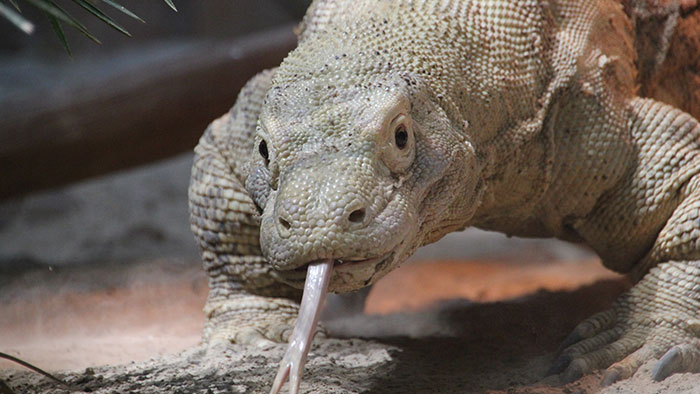Komodo monitors, commonly known as Komodo dragons, are the largest lizards in the world. Their unusual size has evolved as the result of needing less food (a slow metabolism) and not having to compete with other carnivores on their island habitat. A top predator, their hunting strategy is based on stealth and power.
What They Eat
Komodo dragons ambush their prey – typically boar, water buffalo, and deer – and inflict a venomous bite. Then, using their long forked tongue to smell, they track their prey, which usually dies in a few days. Young Komodo dragons feed on insects, small birds, mammals and other reptiles. All age groups eat carrion (dead animals).
Where They Live
These giant reptiles are only found on three small Indonesian islands where the climate is hot and dry for most of the year. They live in dry open grasslands or in the lower levels of tropical forests. After hatching, young live in trees until age four to avoid being eaten by adults.
What They Do
Komodo dragons are largely solitary, coming together only to breed and eat. Female dragons may lay up to 30 eggs in underground nests during the dry season. Females may defend their nest for a period of time after egg laying. Incubation takes approximately 8-9 months. To maintain their body temperatures, Komodos bask in the morning sun and avoid temperature extremes by using shady areas in the afternoon and burrows at night.
How They’re Doing
Komodo dragons are in danger. The species suffers natural and human threats–a small range, increasing human populations, poaching, volcanoes, earthquakes, and tsunamis (tidal waves). The Indonesian government established Komodo National Park in 1980 to protect dragons, and considers it a national treasure.
Where in the World
Asia
Habitat
Island Savanna Tropical Forest
Conservation Status
Animal Facts
Length: Females 6 ft. Males 9 ft.
Weight: Female 100 lbs Males 200 lbs.
Lifespan: estimated 20 years
Taxonomic Category
Amphibian/Reptile
Where at the Zoo
Minnesota Zoo’s original Komodo dragons were a gift from the President of Indonesia where they are a national treasure.
Gasher
In 1992 the National Zoological Garden achieved a milestone by becoming the first institution outside of Indonesia to breed and successfully hatch out komodo dragons. Gasher, our male Komodo dragon, was from that first hatching in October of 1992. In 1993 he was transferred to the Atlanta Zoo and we received him from them in 2001. At that time when he was a young 9-year-old, weighed about 75 pounds, and was roughly 5 feet in length. Today he is a whopping 125 pounds, closer to 8 feet, and fully muscled out. Even at his size we watch how much he eats so he doesn’t put on too much fat, which is a common problem with this species. He is fed 1 1/3 pounds of food twice a week, which includes a variety of items ranging from poults, quail, rat pups, mice, chicks and herring. On exhibit and behind-the-scenes he has heated areas and special light bulbs to simulate natural sunlight. He basks under these as he digests his food. He especially chooses to lay in the areas that heat up to 120 degrees F° !
Sidebar Content
- The saliva of the Komodo dragon contains close to 50 types of bacteria. Additionally, they are now know to have venom.
- Komodos don’t need to eat often, but when they do they can take a lot: up to 80% of their body weight. What’s 80% of your weight?
- Komodo dragons are capable of stretching and unhinging their jaws, which enables them to eat large prey. They usually consume their prey whole, but will tear it into pieces if necessary.
- Infant Komodo dragons may roll themselves in the guts and feces of prey animals to mask their smell and avoid being eaten by mature Komodo dragons.
- Much like a shark, Komodo dragons go through 4 or 5 sets of teeth throughout their life. Their mouth contains 60 sharp teeth, flattened and serrated, and perfect for cutting and tearing food.
Sidebar Content
Komodo dragons are vulnerable due in part to their limited range. Komodo National Park, established in 1980, and strict anti-poaching laws have helped protect the dragons.
The limited range of the remaining wild Komodo dragons puts them at risk from human encroachment, decline or loss of prey, habitat loss, competition with exotic species, and natural catastrophes.
Legal protection of Komodos has reduced commercial hunting, but they are sometimes poisoned by villagers to protect children and domestic animals. The U.S. Fish and Wildlife Service has classified this species as endangered and there is now an area designated as Komodo National Park where the animals are protected.
Things the Zoo's done/doing
The Minnesota Zoo is active in the Komodo Dragon Species Survival Program (SSP), a captive breeding program designed to maintain a genetically healthy population of dragons in captivity. In 2002, on the recommendation of the SSP, one of the Minnesota Zoo’s Komodos was sent to the Toronto Zoo to be paired with two female dragons. The breeding was successful and in 2003, “Satu,” meaning “number one,” was the first Komodo dragon hatched in Canada!
In 1998, BJ Schoeberl, Minnesota Zoo Tropics Supervisor, traveled to Indonesia with five other zoo professionals to collect information on wild Komodo dragons. While there, she observed a wild female nesting and hatchlings emerging from a burrow. The data she helped collect has been extremely helpful to the successful management and breeding of Komodos through the Komodo DragonSSP.















